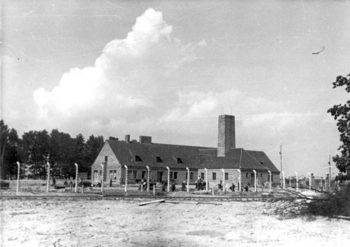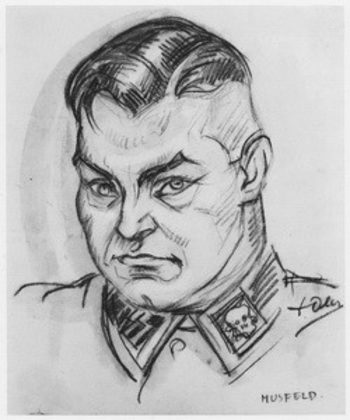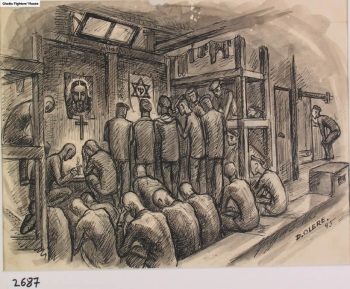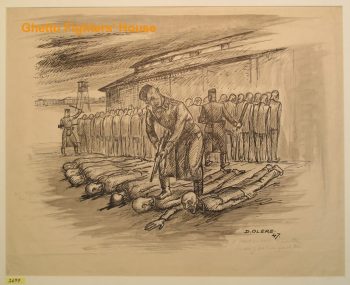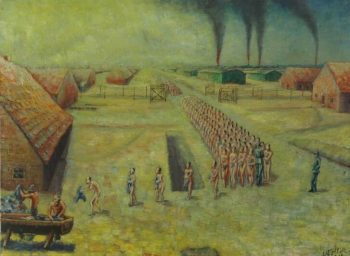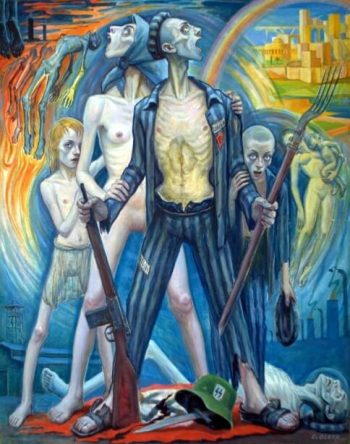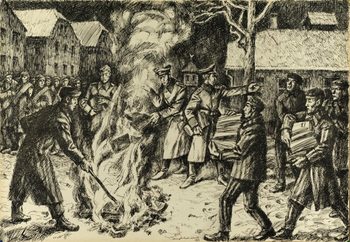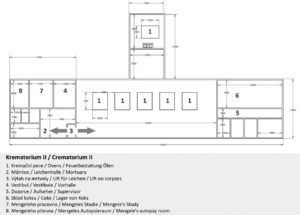History
The construction of Crematorium III is begun. This should be a mirror image of the already constructed Crematorium II. It will have dressing rooms with an area of 392.45 square metres and gas chambers with an area of 210 square metres. At first, both rooms are labelled as Morgue 1 and Morgue 2.
The gas chambers are 30 metres long, 7 metres wide, and 2.41 metres high. The undressing room is 49.49 metres long, 7.93 metres wide, and 2.3 metres high. Experts calculate that, if properly crammed, up to 2,500 people could be killed at once
The reconstruction of the work camp into an extermination camp is approved. Part of the plan is also the construction of two large crematoriums with gas chambers, labelled as Crematorium II and III, and two smaller crematoriums with gas chambers, labelled as Crematorium IV and V. Commandant of the camp Höss receives orders from Berlin regarding what to do with the property of the gassed victims.
The original morgues of Crematoriums II and III are changed to gas chambers in the plans, and hollow columns made of wire are placed inside. A basket with the crystals of Zyklon B is lowered into these columns from the roof.
Both Crematorium II and III have an expected performance of 1,440 cremated bodies in 24 hours, and Crematoriums IV and V have an expected capacity of 536 bodies cremated in 24 hours. The constructors therefore expect that up to 3,952 bodies in 24 hours can be cremated in all four crematoriums. In reality, this performance was never achieved.
Electric lifts by the Topf Company are installed in Crematorium II and III. The lift in Crematorium III has a capacity of 750 kg, and the one in Crematorium II is somewhat smaller. At least ten cadavers can be loaded into the lift, and sometimes more, depending on their bodily proportions. Crematorium III is handed over. At the time of the handing over, the gas chamber already has 14 fake shower-heads installed.
The head overseer of the Sonderkommando, August Brück, dies of typhus. The death of a fairly civil prison functionary calls for changes. Temporarily, thirty-three-year-old Jaakov Kaminski is appointed as the head Kapo. It is completely unprecedented that a Jew should assume such a significant post. This function always belonged to the interned Reich Germans.
Kaminski, however, makes a good impression on the SS officers. He is charming, walks like a dandy with a walking cane, and is civil towards the inmates. He also knows how to organise, maintains order, and has the respect of both SS officers and his inferiors. Although
he yells frequently, he never beats anyone. Since he is able to move freely around the camp in this new job, he begins making contacts with the secret resistance movement.
A partition is put up in the gas chamber of Crematorium II, and probably in Crematorium III, as well, so that smaller groups of victims can be gassed. The brick wall includes an airtight door constructed in the same manner as the doors already used in the gas chambers.
A new railway ramp is built, to be located inside of the Auschwitz II – Birkenau camp and which transports the victims de facto almost all of the way to the courtyard of Crematoriums II and III. The preparations of murdering a large number of Hungarian Jews are culminating. All of them are to be liquidated, and because there are more than 750 thousand, all available camp facilities meant for mass murders are to be used.
Crematoriums II and III operate with only occasional cutbacks from the end of 1943, whereas Crematoriums IV and V are not in operation at all. As a matter of fact, Crematorium IV has been defunct basically since its launching. They are now revised and repaired, including the doors leading to the chambers by the ovens.
On this occasion, the problem of how to kill smaller groups of victims by gassing is solved, as another partition is built in Crematorium V, dividing the smallest gas chamber into two parts. Thus, a small gas chamber with an area of 12 metres squared is established, where a smaller group of people can be killed without wasting gas.
Testimonies about the operations of Crematorium IV diverge, either it launches operations for only a very short time, or it is in such bad shape that it can no longer be repaired and remains to be shut down. In any case, it serves as the quarters for some of the Sonderkommando, and thus logically does not fulfil its original purpose.
Since the ovens of Crematoriums IV and V cannot endure the high performancz in the long run, and their throughput is low, open-air pits for the cremation of cadavers are dug out near Bunker II and behind Crematorium V.
Bunker II is repaired and wooden shacks for undressing victims near it are again constructed. At this point of the camp’s existence, it is sometimes referred to as Bunker V. It is not clear how many wooden buildings for the undressing of victims stand by Bunker II at any given time. Testimonies diverge in the number of two or three. It is possible that in the first and second phases of the operations of Bunker II, the number of buildings differs.
Thirty-one-year-old SS-Oberscharführer Eric Muhlsfeldt arrives at the camp. He becomes the overseer of Crematoriums II and III. He becomes infamous for his brutality.
Until this time, the members of the Sonderkommando have been quartered in Block 11 and 13 in sector BIId. Since there is so much work servicing the crematoriums, Moll decides that the commandos will be accommodated directly in the crematoriums. In Crematoriums II and III, a dormitory is constructed in the attic space, and around 200 prisoners works in each one of them. About 300 members of the Sonderkommando serving Crematoriums V and the pits behind it are quartered in non-functioning Crematorium IV. The rest most probably sleep in Block 11 or 13, and they work in Bunker II. Sometime later, they, too, are moved to Crematorium IV.
Seventeen-year-old Morris Kesselman is assigned to the Sonderkommando, and he becomes the pipel of twenty-six-year-old Kapo Lemke Pliszsek. Both survive, Morris thanks to the protection of the Kapo. Later, both give significant testimony about the events near the gas chambers. Being the youngest member of the commando, Kesselman is often sent for food. He is able to coax the guard, an SS officer of Dutch descent, and sometimes, he is allowed to throw bread into the women’s camp. At the time, the Sonderkommando has enough food from the transport loot
The international resistance organisation in the camp called “Combat Group Auschwitz” sets up the “Auschwitz Military Council”, which is to prepare an armed revolt. People are worried that the Nazis will want to kill all of the prisoners and cover their tracks before the Soviet army arrives.
Another reason for the increased activity is the supposed plan of Otto Moll, who suggests that all prisoners be murdered, the crematoriums be destroyed, and then all of Auschwitz II – Birkenau be obliterated by bombing. It is not certain whether Moll suggested this or not, but the information still spreads among the prisoners.
The resistance members even contact the Sonderkommando, which has a great number of strong and determined young men who are aware that in any case, they shall be killed themselves as unwanted witnesses.
Representing the Sonderkommando in these contacts with the resistance is Kapo Kaminski, who pushes for launching the uprising as soon as possible. He is afraid that soon, the ranks of the Sonderkommando will be reduced, i.e. that its members will be murdered. The resistance protests that the conditions are not yet ideal for the escape of a larger number of prisoners, and that the Nazis could then literally hunt the refugees down. The Soviet army is still far away and the SS officers have the opportunity of calling for reinforcements.
The Sonderkommando prepares a very carefully planned uprising. The prisoners should kill the guards in the crematorium around 4:00 p.m. and then wait for the next shift of SS officers, kill them and take their weapons. After being so armed, they shall start liberating the adjacent sectors of the camp and so unleash a large-scale escape. Everything is ruined by the arrival of 837 prisoners from Majdanek, since they are accompanied by a strong SS officer commando and by the Wehrmacht, who guard them near the crematorium by the Central Sauna, where they are being deloused.
It is clear that the presence of so many armed soldiers means that the entire act is jeopardised, and so Kaminski calls off the entire uprising at the last minute. Those men of the Sonderkommando that were ready to die in battle with the Nazis become apathetic.
SS officer Moll shoots the Kapo of the Sonderkommando, Jaakov Kaminski, probably due to being turned in by Kapo Morawa. Kaminski had told him about the plans for the uprising several days prior, and Morawa did not agree with them. This information is not confirmed, however, and the Jewish Kapo could have been turned in by anybody else.
The overseer of Crematoriums II and III, thirty-one-year-old SS-Oberscharführer Eric Muhlsfeldt, is transferred to the front. His activities in Auschwitz II – Birkenau are finished.
August to September
The combat group, represented by the “Auschwitz Military Council”, begins preparing the plans for a large uprising, counting on the help of the Sonderkommando.
Ultimately, the uprising never takes place, since for some time now, prisoners are being moved further west, further away from the Soviet army. It turns out that not all prisoners are
to be killed, and thus they have a better chance of living to see the end of the war in another camp than in a surely bloody uprising, the positive outcome of which cannot be guaranteed in advance.
An agreement is made between the resistance and the women working in the factory of the “Weischel Union Metallwerke” Company, which manufactures igniters for artillery shells. At least six women, namely Roza Robot, Ester Wajclbjum, Regina Safirrsztajn, Ala Gertner, Marta Cigé and Chaya Koin, participate in the smuggling of gunpowder from the factory into the camp. There, the prisoners make hand grenades using it, which they hand over to Sonderkommando member Jukel Wrobel in the clothing storage. Sometimes, twenty-eight-year-old Eliezer Welbel accepts the material.
The grenades are made out of tin cans, and consist of gunpowder, nails, and shards. Shlomo Dragon hides about 30 such grenades in Block 13. Later, he moves them to Crematorium IV.
The Łódź Ghetto is liquidated, and although the number of the gassed is curtailed, it definitely does not stop completely, as the camp in Theresienstadt still exists.
The Nazis murder 200 members of the Sonderkommando from Crematoriums IV and V, most probably in the disinfection room Canada I. These killed prisoners were quartered in Crematorium IV, near which they are selected for alleged transport to another camp; they almost revolt during this selection, but they eventually obey the commands.
Their death is not really explained, but it seems that they most probably drank with overseer Otto Moll, who is leaving Auschwitz and who promises to take the experienced workers with him to his new place of operation. The Nazis then gas the drunk prisoners.
Then, the Nazis lock the Sonderkommando in the attic of Crematorium II and cremate the bodies of their colleagues in the ovens themselves. Supposedly they are the victims of the bombings. The dead do not burn completely, and so the next day, the prisoners find the charred cadavers in the oven chambers and recognise their murdered colleagues. The atmosphere of hopelessness and apathy only worsens in the Sonderkommando.
The overseer of all crematoriums Otto Moll is transferred, and Peter Voss again assumes this post.
28 September to 28 October
At this time, the transports of Jews from Theresienstadt arrive, and most of the deported people go directly to the gas chambers.
The Jewish prison functionaries of the Sonderkommando get orders from the SS officers to make a list of 300 of their inferiors who should go into the transport. Everyone realises that they are to be murdered. According to the recollections of the surviving prisoners, the Kapos hesitate to obey the command, but eventually this list of death is put together.
The Nazis, as they had many times before, leave the responsibility of choosing those meant for death to their own leaders. This was done earlier in the ghettoes, where the Nazis required lists for the transports, and they are doing it again now.
The Kapos have a dilemma. If they compile the list now, they save themselves and their favourite prisoners. If they do not obey, the Nazis shall choose who will go to the transport themselves, which could also include them. And the defeat of the Germans is approaching, a large uprising is being talked about and everyone still secretly hopes that the camp could be bombed and they will be able to escape in the chaos. They cling to the hope that they will be saved before their turn comes.
A conflict occurs between a Russian Sonderkommando member and a SS officer. When the guard starts to beat the Russian, he attempts to run, and the SS officer wounds him with a gun. When the guard wants to whisk him away, the wounded man plunges at him. In the ensuing fight, the guard shoots him, and then complains to his colleagues about the Russians and requests their departure. The Russians hear about this and worry that they will all be deported and murdered. Although this never happens, the tensions among them rise.
In the morning, the inmates of the Sonderkommando find out that 300 of its members are to be selected and deported. These are usually the inmates that are quartered in Crematorium IV.
A partial agreement, not accepted by all members, is made saying that they shall defend themselves and they shall begin the revolt in Crematorium IV. They are to set fire to their straw pallets and send smoke signals to their colleagues from the other crematoriums. Signals from Crematorium II should be then aimed at Crematorium III. However, it seems that many Kapos and some inmates do not agree with the revolt and want to wait for the large uprising of the entire camp. They are probably ready to sacrifice their three hundred colleagues. It is a difficult decision to make, and certainly not all members of the Sonderkommando are united in how to proceed. Maybe even some of them already know that they are not on the list.
At 1:25 p.m., there is a roll call for all workers in Crematorium V who are quartered in Crematorium IV. Eventually, 286 men remain in the courtyard, and the other 30 are shut in Crematorium V.
SS-Oberscharführer Hubert Busch and SS-Unterscharführer Johann Gorges try to select those inmates meant for the supposed transfer to another camp. At this time, older inmate Chaim Neuhoff pounces on them with a hammer. Others then join him, and the SS officers start shooting from their pistols and run behind the barbed wire. At the same time, they call for reinforcements.
Twenty-eight-year-old Kapo Shlomo Kirszenbaum organises the escape of about 120 prisoners into Crematorium V, where they hope to hide. Many are wounded or killed. Shlomo Dragon also hides in Crematorium V, whereas his brother Abraham remains lying wounded on the path between the crematoriums. Later, he is transported to the hospital. All of the three mentioned above end up surviving both the uprising and the war, as well.
The rest of this part of the Sonderkommando attempts to continue fighting. At this point, the Nazis are already shooting at them from a safe distance, and soon, reinforcements arrive from the barracks with machine-guns.
The prepared grenades are not available, as Shlomo Dragon refuses to hand them out before roll call, since he is waiting for orders to begin the large uprising. When the straw pallets of Crematorium IV are lit on fire, one can no longer go for the grenades due to the flames. They end up not exploding at all, and are buried under the falling roof.
The uprising is soon squelched, and all of the surviving prisoners must lie down in rows in the courtyard of Crematorium V; every third person is shot. Of the total number of 324 inmates, only 44 survive the uprising and the ensuing retaliation near the forest crematoriums. Shlomo Dragon and Filip Müller successfully avoid the executions in the courtyard, and thus do not have to play with fire to see if they will not be one of those shot.
At first, the uprising does not affect Crematoriums II and III, where it remains to be calm until 1:50 p.m. At this time, a unit of SS officers approaches the crematorium, probably just in case in order to prevent an uprising here, as well. The Russian inmates in Crematorium II panic and pounce on Oberkapo Koevent, shoving him into the oven alive. They then attempt to escape, armed only with several knives, a bayonet, and a few home-made grenades. About 100 members of this Sonderkommando escape from the grounds of the crematorium and even make it over the large ditch. Some of them are shot, but part of the group ends up at the fish pond, where they are confronted with an emergency unit on wheels. In this uneven match, all 73 of the inmates are killed, as well as 3 SS officers, who have their throats slit by the rebels. Another 12 SS officers are wounded, also thanks to the weapons of their colleagues that have been overtaken by the rebels.
There remains one small group of refugees that barricades itself in a barn in the village of Rajsko. The barn is lit on fire by SS officers, and the inmates either burn to death or are shot when they come out of the flames.
The four-member medical team of Dr. Mengele’s pathologists remains in Crematorium II. They are forced to lie down along with the arrested members of the Sonderkommando in the courtyard with their foreheads to the ground. Dr. Mengele soon comes to pick them up and leads them away, but the rest of the inmates are shot in the head. Of the 171 members of the special commando servicing Crematorium II, not one survives the uprising.
Nothing is happening in Crematorium III, as Kapo Lemke Plizsko prevents his inferiors from joining the spontaneous uprising. He waits for orders from the Combat Group and denounces this wayward act of the Sonderkommando. What is tragic is that on this day, he loses his brother, who services the sewage system but joins the rebels, since he thinks that the large-scale uprising is beginning. Thus, this Kapo loses his last living relative.
All 168 inmates from Crematorium III survive the uprising, as do Mengele’s pathologists from Crematorium II and 44 men from the forest crematoriums. On the other hand, 452 of their colleagues die. Three are dead on the side of the SS officers.
Already in the evening, 20 members of the Sonderkommando of Crematorium III must leave to service Crematorium II. Their fears that they are being led to their deaths increase when they are forced to undress after arriving at the opposite crematorium. In this moment, they all think that they will be executed and they begin to say farewell to life. However, the SS officers are just searching their clothing. They are then driven to the ovens, and that evening, they cremate the rest of the bodies lying in the morgues. The next day, they begin to cremate the bodies of their shot colleagues.
1,229 prisoners are sent to the gas chambers following a large selection in the women’s camp. Among these inmates are “teen” girls, i.e. those that are younger than eighteen. This group, however, manages to save themselves on this day. At the time that the Sonderkommando uprising is launched, they are already naked in the gas chamber of Crematorium V, but since it is impossible to go through with their murders in the burgeoning chaos, they are sent back to the camp. Some of them end up surviving the war, even though they were already standing naked inside of the gas chambers. Then fifteen-year-old Alice Lok Cahan gives witness to the event after the war.
There is an interesting factor to her story. Although she has been in the camp for several months, she has no idea where they are leading her, even though her fellow inmates had told her about the gas chambers long ago. She believes it to be a classic delousing of clothing and cleansing. This also shows that many prisoners are only familiar with a certain part of the camp.
During the night of 9 to 10 October 1944, apparently several members of the Sonderkommando attempt to blast Crematorium III and are caught in the act. 14 inmates are arrested and led to Block 11 in Auschwitz I, including the five remaining Soviet prisoners of war and two significant leaders of the resistance group, Jankiel Handelsman and Jukel Wrobel.
The number of inmates in the Sonderkommando is decreased to 198. They live in the attic of Crematorium III, and about 30 of them go to work at Crematorium V, where they cremate the camp’s dead.
Esther Wajcblum, who works in the Union Factory and smuggles gunpowder, is arrested. She endures torture and does not reveal anything, she is therefore released.
9 October to 24 October
According to estimates, about 40,000 people are murdered in the gas chambers in this period. Among them are over 14,000 prisoners from Auschwitz who are deemed unfit for transport to other concentration camps in the west. These include the ill, the weak, but also people under the age of 18. All of them are sent to their deaths. Only the strongest who are able to work are to remain alive.
A group of inmates from the Sonderkommando commences to remove the remains of the burnt out Crematorium IV. The paradox of the revolt of their colleagues was that they managed to ruin the only crematorium that was not functional and that served a different purpose.
A command ordering that all boys in Auschwitz under the age of 18 be gassed is made. Some manage to be saved, usually thanks to the prison functionaries and usually by forging their date of birth. The order does not apply to the children that Dr. Mengele uses for his experiments.
Despite of this, the Nazis manage to gather over 600 boys aged 12 to 18. They believe that they are to be transported to work elsewhere, but when they are led to the courtyard of Crematorium III, they realise what awaits them. They have been in the camp for some time and know what purpose the building standing on the courtyard has. Despite of their passive resistance, when they refuse to undress and go towards death, they do not escape their fate. According to the testimonies of the Sonderkommando inmates, this is one of the most horrible scenes that takes place at the crematoriums.
It is probably appropriate to cite the secret records of inmate Lejb Langfuss, which were preserved.
“They were dressed in long, very threadbare striped suits, and had ragged shoes or clogs on their feet. The boys looked so handsome and well-built that not even the rags could cover it up. The boys immediately realised that they were being led to their deaths. They began to run around the courtyard in a panic, ripping their hair from their heads, not knowing how to save themselves. Many of them began to sob, and a piercing wail could be heard. The overseer of the commando and his aide severely beat the boys in order to get them to undress, so much so that they broke their club. Many boys ran in a desperate dash towards the Jews of the special commando, clinging to them and begging for their lives. We stood paralysed by their heartbreaking weeping. The SS officers stood with smug smiles on their faces, without a trace of mercy, with the proud expression of victors, and drove them with great blows into the Bunker.”
A group of fourteen Sonderkommando members, arrested on 9 October 1944, are led to the premises of Crematorium II and shot there.
28 October to 29 October
The last use of the gas chambers in the history of the camp occurs. The victims are selected Jews from the transport of about 2,000 people from Theresienstadt. About 15% of them are admitted to the camp.
Some sources cite that this last mass murder in the gas chambers takes place four days earlier, i.e. on Tuesday, 24 October 1944.
Crematoriums II and III are shut down, and inmates are variously moved about in the Auschwitz II – Birkenau camp. The dismantled barracks in sector BIII travel to the Gross Rosen camp. Interned women are moved to sector BIIb, BIIc, and BIIe. The transports of prisoners further west continue
The news that the gassing of people has been officially halted spreads among the inmates.
The rest of the Sonderkommando is quartered in Block 13 of sector BIId. Since there is no more gassing, their work consists of cremating the camp’s dead, which numbers around one hundred each day. At the same time, they are expected to work on covering the tracks and on dismantling the death factories.
Crematorium II starts to be dismantled. Shortly afterwards, Crematorium III is also begun to be taken apart. All members of the Sonderkommando are assigned to this task, except for the thirty of them who service Crematorium V. The work mostly consists of dismantling the technical equipment that is to be transported further west.
A group of 15 members of the Sonderkommando is sent to collect the straw pallets from Crematoriums II and III. While they are working, a selection takes place in the Sonderkommando, choosing 100 people are taken to and where they are killed. Among them is also chronicler Lejb Langfuss.
According to the testimony of Henryk Tauber, his number was also called out during selection, but since he was with the work unit loading straw pallets, someone else was sent to death. This is just further proof of how the fates of people are decided by happy coincidence. Or by unhappy ones, from the point of view of the inmate that replaced him.
After this action, only 98 men of the Sonderkommando remain to be alive, and 30 of them still work at Crematorium V, and the rest are taking apart Crematoriums II and III.
The ranks of the demolition commando of Crematoriums II and III, comprised by the members of the Sonderkommando, is strengthened by a group of 100 women and several other inmates from the camp, mainly experts from the craftsmen units. On 5 December 1944, another 50 women will join them. This is the first time in the histories of Crematoriums II and III that women who enter the premises return from there alive.
Work moves along quickly, aside from the technical equipment, the roofs are taken apart, the ovens and chimneys are dismantled, and even the ceilings of the basements are taken apart. The aim is to cover any tracks of the mass murders.
The last reduction of the Sonderkommando; the Polish stokers and Kapos are transferred to the concentration camp in Mauthausen. These are Mieczyslav Morawa, Jósef Ilczuk, Wladislav Biskup, Waclav Lipka and Jan Agrestowski. They are most probably shot in Mauthausen as inconvenient witnesses on 3 April 1945
What is left of the Sonderkommando is moved to Block 16 in sector BIId in Auschwitz II – Birkenau; this block is not isolated and they can, for the first time, move freely about the camp.
This is the last day that the members of the Sonderkommando go to work on the demolition of Crematorium II and III. From this day on, they stay in the camp in their block and wait for death. They know that as unwanted witnesses they will not be kept alive. They cannot find any way to save themselves, however.
The last evening roll call of the Sonderkommando takes place, and its members are told to go to their Block 16 and to remain there. They know that once the last regular inmates leave, they will be murdered.
30 members of the Sonderkommando cremate the dead for the last time in Crematorium V, then they join their colleagues and wait for death in Block 16 of sector BIId in Auschwitz II – Birkenau.
The first queues of the remaining prisoners of about one thousand men form, and are controlled at the gate to the card files. Those leaving receive a day’s worth of food, and can take a blanket with them.
Everything changes around 4:00 p.m. A rumour spreads throughout the camp that the Soviet army is approaching. The SS officers panic, encouraged by the thunder of gunfire from the
nearby front that resounds through the camp. The SS officers hastily burn the remaining, untouched documents in open fires. The inmates take advantage of the chaos and pillage the material storage room.
It is at this point that the members of the Sonderkommando decide to attempt a desperate act, that is to mix in with the rest of the inmates. They know that if there will be controls of the list at the gate, they will be discovered. They are also better and differently dressed, as they have been wearing civilian clothing for some time in order to calm the victims going to their deaths. They also have better quality shoes, and are physically better off than the common inmate.
Luckily for them, the SS officers are in a hurry and merely line everyone up into convoys and do not control them according to numbers. At this point, the lists are most probably already burnt. And so the members of the Sonderkommando successfully pass by the chain of guards with dogs all the way to Auschwitz I, where the prisoners gather for another march. It is probable that during the night, the Gestapo tries to find the men from the commando servicing the crematoriums, but there is not enough time to check to immense mass of men, and the needed documents are almost certainly also missing.
The base camp of Auschwitz I is evacuated, and the remaining members of the Sonderkommando find themselves in the convoys, a mere one hundred of the approximately 2,000 men who worked in the Sonderkommando during the camp’s operations. The rest was murdered in the course of events. Since they are fairly well fed and are well-dressed, they survive the death march and almost all of them live to see the end of the war. About 90 men of this special commando are saved.
Nine members of the Sonderkommando successfully escape already during the death march itself, and their escape is facilitated by their good physical condition. This is how twenty-two-year-old Shlomo Dragon, twenty-seven-year-old Henryk Tauber, thirty-four-year-old Stanislav
Jankowski, or twenty-four-year-old Eliezer Eisenschmidt, who is shot in the leg trying to escape but still eludes the Nazis, save themselves.
Another approximately 80 members of the Sonderkommando are liberated by the Americans at the beginning of May in Mauthausen.
It is also necessary to count the other 17 survivors who serviced the gas chambers and cadaver burning at the Bunkers in 1942, but managed to get into other commandos during the early phase of this horrible work.
On this day, the remaining parts of Crematoriums II and III yet to be dismantled are blasted
